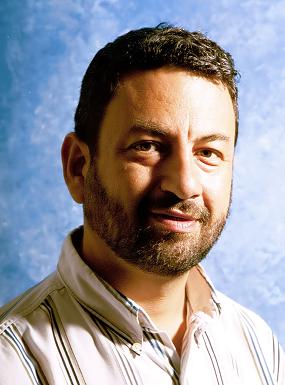The deeper the more accessible
Avi Blizovsky

In the photo: Prof. Dan Blumberg Photographed by: Danny Machlis
Uncovering natural treasures and archaeological finds buried in the ground will be possible using synthetic radar. This was revealed in a new study conducted in the remote sensing laboratory of the Department of Geography at Ben-Gurion University. The research is led by Prof. Dan Blumberg, from Ben-Gurion University, who has a background in the field of synthetic radar from NASA, and his research partners Prof. Yiftach Ben Asher from Ben-Gurion University and Prof. Valentine Freuilicher from Bar-Ilan University. The findings of the study were published ahead of the annual meeting of the Board of Trustees of Ben-Gurion University, which convenes for its annual meeting on May 28, 2006.
The work of Blumberg and his partners led to the creation of a theoretical model, according to which they built a physical model of the radar. For the purpose of the study, the researchers placed pieces of aluminum under the sands of the Negev, at different depths, installed the radar on a rented plane and then scanned the area by flight. The results of the study led to the conclusion that the radar sensors did reveal the location of the hidden pieces of metal.
"The ability to understand what is hidden under the surface of the ground is very fascinating, and it poses additional challenges to the researchers," says Bloomberg. to the surface of other planets".
"Using the radar, you can identify any object with electrical properties, different from the electrical properties of the environment. An electrical contrast between the bone and the environment is required in order to locate the buried object," says Prof. Blumberg. The research conclusions have a direct impact mainly in the agricultural, archaeological and infrastructure mapping, water, electricity, underground power line mapping, soils, minefields and more. It will also be possible to map the depth of the regolith (the non-cohesive material of the earth on the moon), to understand the processes that created the landscape on the moon and the geological history of the moon and to map the shallow subsoil of Mars.
In addition to identifying archaeological sites, Prof. Blumberg seeks to identify, in his work, also various geological patterns. Today, most satellites use microwaves whose wavelengths are shorter than C-band, because they produce "sharper" images and require smaller antennas. In contrast, the radiation of P-band waves penetrates deeper and therefore it is very important to add these sensors to the satellites in order to create optimal conditions for scanning the subsoil.
For the past three years, Bloomberg and his partners have been working on improving the capabilities to map soil moisture in agricultural fields in arid environments using images taken in P-band and shorter wavelengths (C-band). Another interesting application will allow the identification of mines, which may save lives.
***Synthetic radar is a radar that is not affected by weather conditions. The wonderful capabilities of the synthetic radar were demonstrated during the flight of the American spacecraft Magellan to the planet Vega. Compared to the optical cameras, the greatness of the synthetic radar is its ability to map the surface of the ground, when the clouds do not affect it. The information sent by the synthetic radar in Magellan was translated by a computer into visual images and thus for the first time the land route of Naga was revealed including volcanoes, valleys, plateaus. The research was funded through the Ministry of Science and the Israel Space Agency.
https://www.hayadan.org.il/BuildaGate4/general2/data_card.php?Cat=~~~483278631~~~64&SiteName=hayadan
